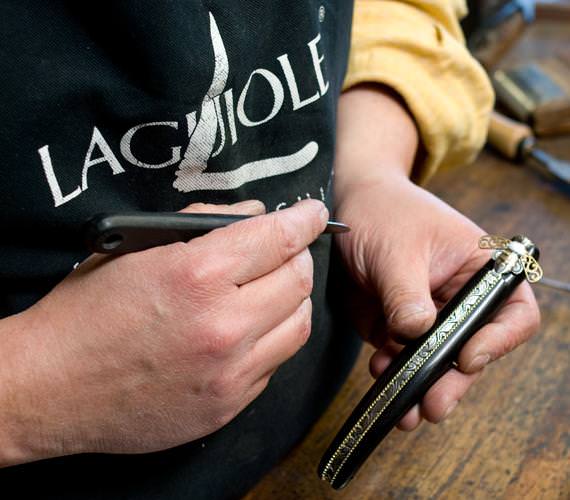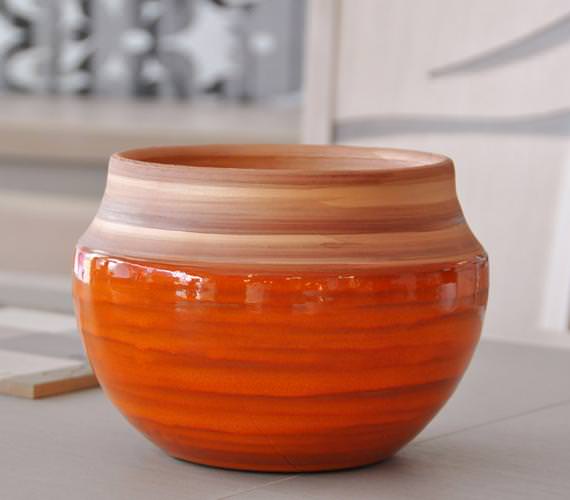
Couteaux de Laguiole, Thierry Moyset / Forge de Laguiole

Gant de Millau

Peigne en corne d'Ariège, D.Viet

Poteries d'Albi, Poteries d'Albi
Traditional, ancestral and… contemporary! The "Made in Occitania" deploys its talents in countless sectors. In France and abroad, everyone knows Perrier, Roquefort, Laguiole knives or Anduze pottery. Millau gloves and Caussade hats have been seen in the fashion shows of the great designers.

Gant de Millau
Looking for a bag, a hat or some gloves? In Latour-sur-Sorgues, you can find the authentic Sac du Berger bags made from Cévennes leather. In Caussade, Willy’s Paris has been inventing and making wonderful hats since 1857. In Millau, the French leather capital, you can slip the most beautiful items onto your fingers: gloves from the Causse Gantier workshop or from the Maison Fabre Ganterie.
If you prefer a chaise longue and espadrilles, head for Saint-Laurent-de-Cerdans for fabrics made by Toiles du Soleil.

Espadrilles de Saint-Laurent-de-Cerdans, Création Catalane - Saint-Laurent-de-Cerdans
Our favourite
Catalonian jewellery. Garnet was once mined on Mount Canigó. It is still set and mounted at the Manufacture du Grenat workshop in Perpignan, where you can admire the work of Catalonian jewellers.
Only in Laguiole, in northern Aveyron and nowhere else, the legendary Laguiole knives are made. Often imitated, never equalled, they are manufactured in around ten different workshops. So we recommend a visit to the Laguiole Forge with buildings designed by Philippe Starck, and to the other cutlery-makers in Laguiole.
Elsewhere, in Lozère, Ariège or Tarn, craftsmen manufacture fine blades, faithfully reproducing traditional farmers' knives or up-to-date variations for today's dining tables.

Couteau de Laguiole, Arnaud Lizeray
Original
Unique in France! In Ariège, in Lesparrou and Laroque-d’Olmes, can be found the last two manufacturers of hand-made natural bone combs. Using craftsmanship dating back to the 12th century.
In Vergèze, the Perrier source opens up its plant so you can see out how the famous little bubbles are bottled. The Salin d’Aigues-Mortes provides an exciting introduction to the life of salt makers in Camargue.
In Roquefort-sur-Soulzon, you can go deep down into the Roquefort cheese cellars. In Toulouse, enjoy a guided visit to see the unique products made using woad: soaps, cosmetics and clothes.

La source Perrier, Droits réservés
A good cassoulet must be enjoyed in a cassole dish. This is a clay dish made at Poterie Not, in Mas-Saintes-Puelles, on the Canal du Midi.
At the gates of Cévennes, the Poterie de la Madeleine and a large number of craftspeople make the highly sought-after Anduze vases.
The Poteries d’Albi produce wonderful vases for the garden and the home, while in Puy-L’Evêque, the Virebent porcelain workshop creates fine contemporary objects sold in the most elegant home-decoration stores all over the world.

Poteries d'Albi, Poteries d'Albi
Well worth a visit
In the village of Martres-Tolosane south of Toulouse, 5 faience workshops are continuing the art of using high-temperature kilns (between 900 and 1000°C) to make delicate pottery decorated with floral patterns.

Carrière de talc en Ariège, D.Viet
Louis XIV chose red marble from Caunes-Minervois to decorate Versailles. The Carrière du Roy (King's quarry) is still active and open to visitors.
You will also be impressed by the biggest granite quarry in France in Vialavert in the Sidobre region, near Castres.
In Luzenac, you can visit the Trimouns talc quarry, one of the biggest in the world.

How to get there?